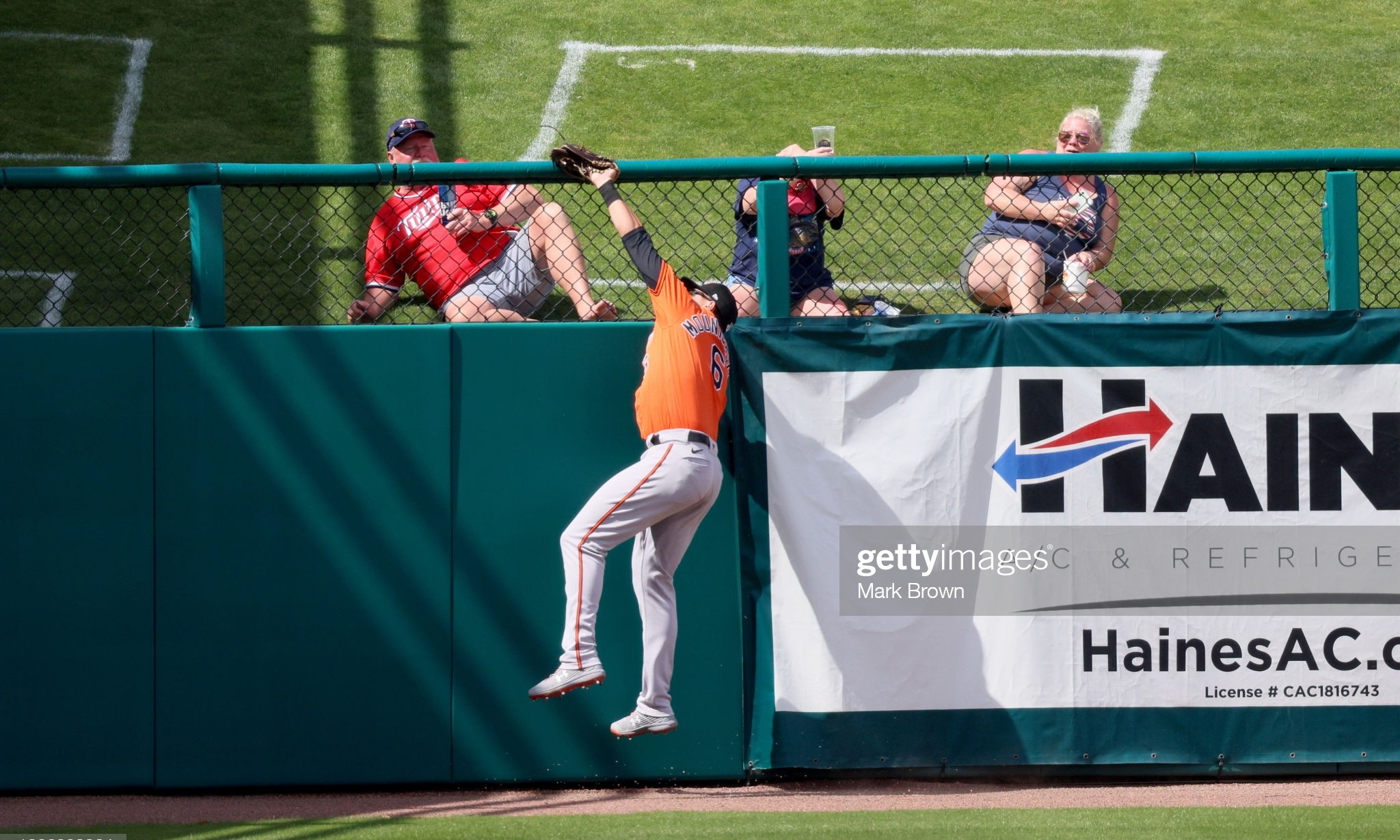The 2021 MLB season is only 10 days away. As it approaches, let’s take a look around the AL East and see who on each team could be break out and establish themselves as regular contributors at the major league level.
Baltimore Orioles: Ryan Mountcastle
Right off the bat, I’m kind of cheating here. Mountcastle is Baltimore’s #5 prospect, and had a great showing in 2020. But since he still has yet to play a full season, I’m counting it.
In 2020, Mountcastle hit .333 with 5 home runs and a 140 OPS+ across 35 games. While he may have gotten a bit lucky (.398 BABIP, .266 xBA), he still flashed some impressive tools.
Mountcastle had a hard-hit percentage of 41.8%, and a barrel rate of 7.1%. He showed that he can hit breaking pitches as well, batting .327 in at-bats that ended with a breaking ball (from Baseball Savant).
Mountcastle is an aggressive hitter, as well. Just take a look at these numbers, from Baseball Savant:
- Swing %: (58.8%) League Average: (46.9%)
- Zone Swing %: (81.1%) League Average: (66.6%)
- 1st Pitch Swing %: (46.4%) League Average: (29%)
He’s also sneaky-quick on the basepaths. His sprint speed ranked in the 78th percentile across the entire league last season.
“I always thought I’ve been pretty fast,”, Mountcastle told MLB.com’s Joe Trezza. “I guess it’s an underrated part of my game.”
Mountcastle is still only 24 years old, and has continued last season’s success this spring. Entering Monday, he’s hit three home runs, with an .882 OPS, in 12 games.
With the Orioles still in rebuild mode, Mountcastle will see plenty of playing time in the 2021 season. He can play several positions, and should see time at first base and in the outfield. Fans of AL East teams should expect to see a lot of him this season. Don’t be surprised if he ends up becoming the AL Rookie of the Year.
Boston Red Sox: Bobby Dalbec
The Red Sox might be the surprise of the AL East this year. They still have a sneaky-good lineup, and the pitching staff (particularly the rotation) probably won’t be as bad as people think.
Again, I’m kind of cheating with this pick. Dalbec breaking out probably won’t be a huge surprise. He’s the #3 prospect for the Sox, and the organization is very high on him. He is absolutely crushing the ball this spring, as well.
Dalbec has hit 5 home runs, and posted an OPS of 1.218, in 14 Spring Training games. His play has predictably earned the praise of manager Alex Cora, who said, “I’m looking forward to him going out there and keep getting better and help us out to win games.”
One thing that Dalbec will need to work on is strikeouts. In his 2020 callup, he struck out 39 times in 92 plate appearances (a K rate of 42.4%). Of course, this is a relatively small sample size (Dalbec played only 23 games). Dalbec struck out at somewhat high rates in the minors, as well, but saw his K rate decrease as he progressed. (32% K rate between Low A and AA in 2018, 24.7% between AA and AAA in 2019).
The 25-year-old slugger will likely be Boston’s starting first baseman this season, which will give him plenty of opportunities to establish himself. Playing in the uber-competitive AL East will also give Dalbec opportunities to prove he can hit against elite pitching. Don’t be surprised if he puts together a full campaign, and approaches 30 home runs this season.
New York Yankees: Michael King
I’ve written about Michael King quite a bit in recent months. In my original Yankee roster projection, I talked about how he’s worked to refine his offspeed stuff. Let’s take a deeper dive.
On the surface, you may wonder, why King? After all, he had a 7.76 ERA in 2020, allowing 23 earned runs in 26 & 2/3 innings. But the Michael King we’ll see in 2021 will be much different from 2020’s King.
King made several adjustments during this past offseason. Here’s what Yankees beat writer Bryan Hoch had to say about them:
“King benefited from his time at the Yankees’ alternate training site this past summer, where he huddled with pitching coordinator Sam Briend to refine the axis of his changeup, giving it a different profile than his fastball. The right-hander saw results in the AL Division Series, retiring all six Rays he faced in a Game 3 relief appearance.”
That wasn’t all that he worked, on however. Hoch also mentioned that King reworked his slider into a curveball. He’s been seeing the results so far in Spring Training, as well.
This spring, King has allowed 5 earned runs in 13 innings (3.46 ERA). He’s also struck out 12 batters, to go against 6 walks.
The Yankees already have one of the most complete rosters in baseball. They are favored to win the AL East, and are also one of the preseason favorites for the World Series. King is hoping his new adjustments can earn him an impact role with the team in 2021.
Tampa Bay Rays: Michael Wacha
The Rays are always a tough team when it comes to lists like this. With the way they develop players, it seems like anyone could break out at any possible time.
Michael Wacha, however, is my pick here. This mainly has to do with Tampa’s track record of developing pitchers. Of course, Wacha has already put together several very strong seasons. Unfortunately for him, however, those seasons are a ways behind him.
In Wacha’s first three seasons, he posted a 3.21 ERA (118 ERA+) in 353 innings. However, his career has been a bit up-and-down since then.
In 2016, he struggled, posting a 5.09 ERA (80 ERA+, 20% worse than league average). He also allowed a sweet-spot percentage of 37%, the highest mark of his career.
Wacha bounced back a bit in 2017, but it’s been all downhill since then. In the past three seasons, here is Wacha’s xERA from each year:
- 2018: (5.41)
- 2019: (5.90)
- 2020: (4.61)
He posted a 6.62 ERA last season. And while his xERA was a lot lower, suggesting that he got a bit unlucky, he was still by no means good. He had an FIP of 5.25, and his Baseball Savant profile isn’t pretty to look at:

But a move to Tampa could be just what he needs to figure it out. As you can see, the only stat that stands out from the above table is Wacha’s walk rate. He had a walk rate of just 4.5% last season, the lowest of his career by far.
If Spring Training is any indication, he’s in great shape. Wacha has yet to allow a run this spring, tossing seven scoreless innings. He’s struck out five, allowing just a pair of hits and one walk.
Despite the AL East featuring a plethora of great hitters, don’t be surprised if Wacha rebounds and plays a big role for Tampa this year.
Toronto Blue Jays: Nate Pearson
The Blue Jays already boast one of the best lineups in the American League, much less the AL East. However, pitching is where they struggle. After ace Hyun-Jin Ryu, the rest of Toronto’s rotation is seriously lacking.
Originally, I wanted to pick someone other than Pearson, solely because he is Toronto’s top prospect, and I’ve already picked two other top five prospects in this article. I was first thinking about Steven Matz. That is, until I saw this:

Going back to Pearson, he’s the team’s top prospect for a reason. He put together a great performance in Game 2 of the AL Wild Card, after struggling a bit during the regular season.
The biggest thing that Pearson needs to work on is his control. In 15 regular-season innings last year, he issued 13 walks (walk rate of 16%). He features a big fastball, one that can hit triple-digits on the radar gun, as well as several plus offspeed/breaking pitches.
He had an xBA of .210 in at-bats ending with his slider last season. The pitch has good movement, with 6.6 inches of horizontal movement (21% above league average).
Pearson also features a curveball and a changeup, but we didn’t see much of them in 2020. He threw just 22 changeups, and 21 curves across his 18 regular-season innings. The fastball/slider combo accounted for 86.7% of all pitches he threw last year.
We haven’t seen much of Pearson this spring, however. He strained his groin during his first Spring Training outing, and re-aggravated it last week. He’s expected to miss Opening Day, with Ross Stripling likely to take his spot in the rotation.
When Pearson does return, he will have to play a big part of the rotation if Toronto wants to compete. As soon as he gets his control down, he has a chance to dominate.




